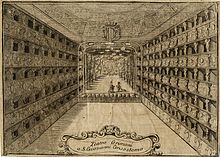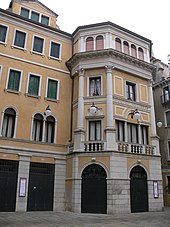Malibran Theater

The Teatro Malibran , formerly the Teatro San Giovanni Grisostomo (today mostly: Crisostomo ) is an opera house in the Cannaregio district of Venice , which is located about fifty meters east of the church of San Giovanni Crisostomo . It is known for its extraordinary importance for opera in the 17th and 18th centuries. The theater was richly decorated and comprised five floors of boxes and a large ground floor. Today there are no boxes to the side and two tiers at the back.
history
The theater was designed by Tommaso Bezzi for the Grimani family and inaugurated during Carnival in 1678 with a performance of Vespasiano by Carlo Pallavicino . At that time the theater had the largest stage in Venice and was known for its extraordinarily lavish productions and its good singers - such as Margherita Durastanti , who worked here as prima donna from 1709 to 1712. The heyday of the theater was associated with composers such as Carlo Francesco Pollarolo , Alessandro Scarlatti and Georg Friedrich Händel . The castrato Farinelli also stood on the stage of this house.
One of Venice's premier theaters began to decline in the 1730s, although this was typical of most theaters in the mid-18th century. In 1737, when Carlo Goldoni was in charge of the theater, his plays and other plays were given here. In 1755 the Grimani family opened a new and smaller theater, the San Benedetto , which made the San Giovanni Grisostomo even less important among the theaters in Venice.
After the French occupation of Venice in 1797, this theater was one of the few that did not close. In 1819 it was bought by Giovanni Gallo, who restored it in 1834, and in 1837 it was named Teatro Malibran in honor of its patron, the famous Spanish mezzo-soprano Maria Malibran . In 1849 the Austrians returned to Venice, leaving only one of the numerous theaters open.
In 1919 the theater reopened after a number of years and was a center for opera, operetta and also served as a cinema hall in the first half of the 20th century . In 1992 the theater was acquired by the city of Venice, on which occasion it was restored and expanded.
After the fire at Teatro La Fenice (1996), Teatro Malibran was quickly renovated and reopened in 2001. Since then, the house has been used by the ensemble of the Teatro La Fenice. Marcello Viotti , the first musical director after the reopening, stipulated in his usage concept that the house would be used for the performance of the Baroque repertoire and Mozart operas.
First performances 1678 to 1808 (selection)
- Vespasiano by Carlo Pallavicino , 1678
- Nerone by Carlo Pallavicino, 1679
- Il ratto delle Sabine by Pietro Simone Agostini , 1680
- Antioco il grande by Giovanni L Limiti , 1681
- Creso by Giovanni L Limiti, 1681
- Flavio Cuniberto by Gian Domenico Partenio , 1681
- Carlo re d'Italia by Carlo Pallavicino, 1682
- Flavio Cuniberto by Domenico Gabrielli , 1682
- Il re infante by Carlo Pallavicino, 1683
- Licinio imperatore by Carlo Pallavicino, 1683
- Ricimero re de 'Vandali by Carlo Pallavicino, 1684
- Massimo Puppieno by Carlo Pallavicino, 1685
- Penelope la casta by Carlo Pallavicino, 1685
- Amore inamorato by Carlo Pallavicino, 1686
- Didone delirante by Carlo Pallavicino, 1686
- L'amazone corsara, ovvero L'Alvida regina de 'Goti , 1686
- Elmiro re di Corinto by Carlo Pallavicino, 1686
- La Gerusalemme liberata by Carlo Pallavicino, 1687
- Carlo il Grande by Domenico Gabrielli, 1688
- Orazio by Giuseppe Felice Tosi , 1688
- La pace fra Tolomeo e Seleuco by Carlo Francesco Pollarolo , 1691
- Onorio in Roma by Carlo Francesco Pollarolo, 1692
- L'Ibraim sultano by Carlo Francesco Pollarolo, 1692
- La forza della virtù by Carlo Francesco Pollarolo, 1693
- Ottone by Carlo Francesco Pollarolo, 1694
- Irene by Carlo Francesco Pollarolo, 1694
- Il pastore d'Anfriso by Carlo Francesco Pollarolo, 1695
- La Rosimonda by Carlo Francesco Pollarolo, 1695
- Ercole in cielo by Carlo Francesco Pollarolo, 1696
- Amor e dovere by Carlo Francesco Pollarolo, 1696
- Marzio Coriolano by Carlo Francesco Pollarolo, 1698
- Il Faramondo by Carlo Francesco Pollarolo, 1698
- Il repudio d'Ottavia by Carlo Francesco Pollarolo, 1699
- Lucio Vero by Carlo Francesco Pollarolo, 1699
- Il colore fa 'la regina by Carlo Francesco Pollarolo, 1700
- Il delirio comune per l'incostanza dei genii by Carlo Francesco Pollarolo, 1700
- Catone Uticenze by Carlo Francesco Pollarolo, 1701
- L'odio e l'amore by Carlo Francesco Pollarolo, 1702
- Venceslao by Carlo Francesco Pollarolo, 1703
- La fortuna per dote by Carlo Francesco Pollarolo, 1704
- Il giorno di notte by Carlo Francesco Pollarolo, 1704
- Il Dafni by Carlo Francesco Pollarolo, 1705
- Filippo, re della Grecia by Carlo Francesco Pollarolo, 1706
- Flavio Bertarido, re dei Longobardi by Carlo Francesco Pollarolo, 1706
- Il selvaggio eroe by Antonio Caldara , 1707
- Alessandro in Susa by Luigi Mancia , 1708
- Sofonisba by Antonio Caldara, 1708
- Il vincitor generoso by Antonio Lotti , 1709
- Agrippina by Georg Friedrich Handel , 1709
- Ama più chi men si crede by Antonio Lotti, 1709
- Il comando non inteso et ubbidito by Antonio Lotti, 1710
- Isacio tiranno by Antonio Lotti, 1710
- Il tradimento traditor di se stesso by Antonio Lotti, 1711
- La forza del sangue , by Antonio Lotti, 1711
- L'infedeltà punita by Antonio Lotti, 1711
- Publio Cornelio Scipione by Carlo Francesco Pollarolo, 1712
- L'infedeltà punita by Carlo Francesco Pollarolo, 1712
- Spurio postumio by Carlo Francesco Pollarolo, 1712
- Porsenna by Antonio Lotti, 1713
- Irene Augusta by Antonio Lotti, 1713
- Semiramide by Carlo Francesco Pollarolo, 1714
- Il germanico by Carlo Francesco Pollarolo, 1716
- Foca suberbo by Antonio Lotti, 1716
- Ariodante by Carlo Francesco Pollarolo, 1716
- Alessandro Severo by Antonio Lotti, 1717
- Eumene by Tomaso Albinoni , 1717
- Astianatte by Antonio Maria Bononcini , 1718
- Ifigenia in Tauride by Giuseppe Maria Orlandini , 1719
- Leucippo e Teonoe by Antonio Pollarolo , 1719
- Paride by Giuseppe Maria Orlandini, 1720
- Il Lamano by Michelangelo Gasparini , 1720
- Teodorico by Giovanni Porta , 1720
- Nerone by Giuseppe Maria Orlandini, 1721
- Lucio Papirio dittatore by Antonio Pollarolo, 1721
- Plautilla by Antonio Pollarolo, 1721
- Giulio Flavio Crispo by Giovanni Maria Capelli , 1722
- Romolo e Tazio by Carlo Luigi Pietragrua , 1722
- Venceslao by Giovanni Maria Capelli, Antonio Pollarolo and Giacomo Porta , 1722
- Mitridate, re di Ponto vincitor di se stesso by Giovanni Maria Capelli, 1723
- Gli equivoci d'amore e d'innocenza by Francesco Gasparini , 1723
- Ipermestra by Geminiano Giacomelli , 1724
- Il trionfo della virtù by Francesco Brusa , 1724
- Il più fedel tra gli amici by Michelangelo Gasparini, 1724
- Berenice by Giuseppe Maria Orlandini, 1725
- Siface by Nicola Porpora , 1725
- Il trionfo di Flavio Olibrio by Giacomo Porta, 1726
- Meride e Selinunte by Nicola Porpora, 1727
- Aldiso by Giacomo Porta, 1727
- Arianna e Teseo by Nicola Porpora, 1727
- Argene by Leonardo Leo , 1728
- Ezio by Nicola Porpora, 1728
- Catone in Utica by Leonardo Leo, 1729
- Semiramide riconosciuta by Nicola Porpora, 1729
- L'abbandono di Armida by Antonio Pollarolo, 1729
- Onorio by Francesco Ciampi , 1729
- Artaserse by Johann Adolf Hasse , 1730
- Idaspe by Carlo Broschi , 1730
- Massimiano by Giuseppe Maria Orlandini, 1731
- Demetrio by Johann Adolf Hasse, 1732
- L'Issipile by Giacomo Porta, 1732
- Epaminonda by Geminiano Giacomelli , 1732
- Adriano in Siria by Geminiano Giacomelli, 1733
- Merope by Geminiano Giacomelli, 1734
- La clemenza di Tito by Leonardo Leo, 1735
- Rosbale by Nicola Porpora, 1737
- Demofoonte by Gaetano Latilla , 1738
- Alessandro Severo by Andrea Bernasconi , 1738
- Viriate by Johann Adolf Hasse, 1739
- Ottone by Gennaro D'Alessandro , 1740
- Oronte re de 'Sciti by Baldassarre Galuppi , 1740
- Didone abbandonata by Andrea Bernasconi, 1741
- Tigrane from Giuseppe Arena , 1741
- Merope by Niccolò Jommelli , 1741
- Statira by Nicola Porpora, 1742
- Il Bajazet by Andrea Bernasconi, 1742
- Semiramide by Niccolò Jommelli, 1742
- La ninfa Apollo by Andrea Bernasconi, 1743
- Arsace by Baldassarre Galuppi, 1743
- Siroe re di Persia by Gennaro Manna , 1743
- Meride e Selinunte by Pietro Chiarini , 1743-4
- Ipermestra by Christoph Willibald Gluck , 1744
- Semiramide riconosciuta by Johann Adolf Hasse, 1744
- Antigono by Andrea Bernasconi, 1745
- Sofonisba by Niccolò Jommelli, 1745
- Artaserse by Girolamo Abos , 1746
- Tito Manlio (second version) by Niccolò Jommelli, 1746
- Evergete by Lorenzo Gibelli , 1748
- Ciro riconosciuto (second version) by Niccolò Jommelli, 1749
- Siroe by Gioacchino Cocchi , 1750
- Artaserse by Antonio Gaetano Pampani , 1750
- Didone abbandonata by Gennaro Manna, 1751
- Le nozze di Paride by Baldassarre Galuppi, 1756
- Cajo Mario by Baldassarre Galuppi, 1764
- Notte si fausta by Ferdinando Bertoni , 1764
- Achille in Sciro by Florian Leopold Gassmann , 1766
- Il finto pazzo per amore by Michele Mortellari , 1779
- L'arrivo del burchiello da Padova a Venezia by Luigi Caruso , 1780
- Il geloso corretto by Francesco Gnecco , 1803
- Il finto fratello by Francesco Gnecco, 1803
- La prima prova dell'opera Gli Orazi e Curiazi by Francesco Gnecco, 1803
- Irene e Fliandro by Luigi Antonio Calegari , 1808
See also
literature
- Luca Zoppelli: Venice. In: Stanley Sadie (Ed.): The New Grove Dictionary of Opera. Volume 4: Roe - Z, Appendices. Macmillan et al., London et al. 1998, ISBN 0-333-73432-7 , pp. 913 ff.
Individual evidence
- ^ Derek Weber: Opera house on historical ground - reopening of the Teatro Malibran in Venice. In: Neue Zürcher Zeitung , October 12, 2001.
Web links
- Lucas Christ: Breve storia del Teatro Malibràn
- Derek Weber: Opera house on historic ground - reopening of the Teatro Malibran in Venice - NZZ , October 12, 2001
- General information (ital.)
- Teatro Malibran - orchestra pit and stage
- Teatro Malibran - auditorium
Coordinates: 45 ° 26 ′ 21 ″ N , 12 ° 20 ′ 14 ″ E

